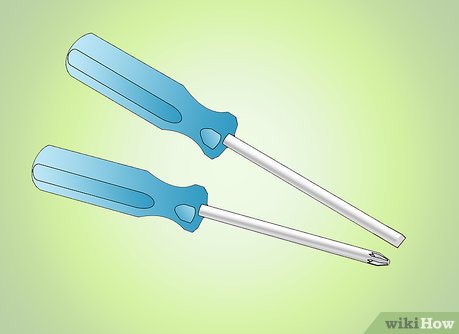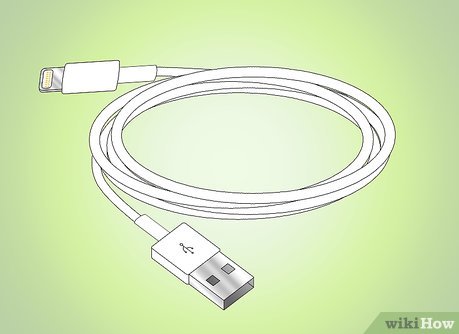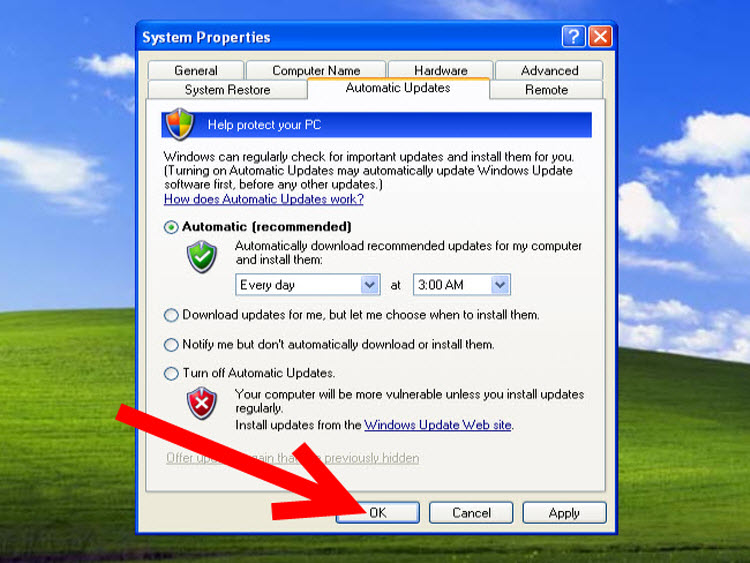How to Be Prepared for Common Technology Problems
Method 1 of 5:
Computers: General
-
 Carry a small pair of screwdrivers: one standard, one Phillips (standard has a "-" shaped head, Phillips has a "+" shaped one). These (particularly the Phillips one) come in very handy when disassembling a computer.
Carry a small pair of screwdrivers: one standard, one Phillips (standard has a "-" shaped head, Phillips has a "+" shaped one). These (particularly the Phillips one) come in very handy when disassembling a computer. -
 Carry short lengths of cable, and several adapters. I recommend one Cat5e ethernet cable, one USB cable (the ones with one rectangular end and one square end, both male type, are preferred as these are the most common for connecting peripherals like CD/DVD drives, external hard drives, etc.), one USB to PS2 adapter (PS2 is an older connector which was common for keyboards, mice, etc.), and one 1/8" audio cable (both ends male type), which will allow you to connect an mp3 player or CD player to a computer or speaker system which has an 'aux in' port.
Carry short lengths of cable, and several adapters. I recommend one Cat5e ethernet cable, one USB cable (the ones with one rectangular end and one square end, both male type, are preferred as these are the most common for connecting peripherals like CD/DVD drives, external hard drives, etc.), one USB to PS2 adapter (PS2 is an older connector which was common for keyboards, mice, etc.), and one 1/8" audio cable (both ends male type), which will allow you to connect an mp3 player or CD player to a computer or speaker system which has an 'aux in' port. -
 Carry a set of four AA batteries, and a set of four AAA batteries. Many devices, including some digital cameras, use these batteries.
Carry a set of four AA batteries, and a set of four AAA batteries. Many devices, including some digital cameras, use these batteries. -
 Carry a blank flash drive (or at least one with some space left on it). You can use it to move files from computer to computer.
Carry a blank flash drive (or at least one with some space left on it). You can use it to move files from computer to computer. -
 Carry a blank CD (in it's case). This is useful if you ever need to burn a bootable CD, for example, if someone needs a CD so that they can install Linux.
Carry a blank CD (in it's case). This is useful if you ever need to burn a bootable CD, for example, if someone needs a CD so that they can install Linux. -
 If you can, carry a grounding band. This is a watchband-like wrist strap with a metal inner lining. The lining is connected to a cable, which gets plugged into the ground pin of an electrical outlet. SAFETY HAZARD: read the warnings section!
If you can, carry a grounding band. This is a watchband-like wrist strap with a metal inner lining. The lining is connected to a cable, which gets plugged into the ground pin of an electrical outlet. SAFETY HAZARD: read the warnings section! -
 If you carry a grounding band, also pick up some ESD bags. These are greyish zip-lock type bags which can be used to store sensitive electronic parts. They shield the part from sparks (e.g. one you might get from static electricity).
If you carry a grounding band, also pick up some ESD bags. These are greyish zip-lock type bags which can be used to store sensitive electronic parts. They shield the part from sparks (e.g. one you might get from static electricity). -
 Carry a small USB Hub. Most peripherals can be connected by USB cables and computers frequently don't have enough ports (particularly laptops).
Carry a small USB Hub. Most peripherals can be connected by USB cables and computers frequently don't have enough ports (particularly laptops).
Method 2 of 5:
Computers: Software
-
 Using a blank CD (or an empty >1GB flash drive, if you have one) create an ophcrack livecd (download [1]. Ophcrack is a program which cracks Windows passwords using LM hashing and Rainbow tables. In short, it can find out a forgotten Windows password in minutes - very useful, since if you forget your Windows password the only option is usually to format the drive.
Using a blank CD (or an empty >1GB flash drive, if you have one) create an ophcrack livecd (download [1]. Ophcrack is a program which cracks Windows passwords using LM hashing and Rainbow tables. In short, it can find out a forgotten Windows password in minutes - very useful, since if you forget your Windows password the only option is usually to format the drive. -
 If you have a spare flash drive (maybe an older (512MB or so) one that you've since replaced), set it up to run common programs. It's very useful to be able to use your own favorite, customized web browser instead of IE6 on a library computer, or to boot up a school terminal using Damn Small Linux (a portable Linux build which takes up less than 50MB). Try putting your favorite browser and DSL on the drive, but if you have space left over you could run other software as well.
If you have a spare flash drive (maybe an older (512MB or so) one that you've since replaced), set it up to run common programs. It's very useful to be able to use your own favorite, customized web browser instead of IE6 on a library computer, or to boot up a school terminal using Damn Small Linux (a portable Linux build which takes up less than 50MB). Try putting your favorite browser and DSL on the drive, but if you have space left over you could run other software as well.
Method 3 of 5:
Portable Electronics/Gadgets
-
 Carry a pair of ear buds. You never know when someone might need to borrow some headphones.
Carry a pair of ear buds. You never know when someone might need to borrow some headphones. -
 Carry an SD card reader. This is the most common type of digital camera memory, and it is useful to be able to copy these files to a computer. If you have a blank SD card, it can double as a type of flash drive.
Carry an SD card reader. This is the most common type of digital camera memory, and it is useful to be able to copy these files to a computer. If you have a blank SD card, it can double as a type of flash drive.
Method 4 of 5:
Miscellaneous
-
 Carry a few rubber bands. They're incredibly useful.
Carry a few rubber bands. They're incredibly useful. -
 Also carry a couple zip-ties. Maybe two large and three small. They are more durable and permanent than rubber-bands, and also quite useful.
Also carry a couple zip-ties. Maybe two large and three small. They are more durable and permanent than rubber-bands, and also quite useful. -
 Carry a pen and pad of post-its. Invaluable for writing things down.
Carry a pen and pad of post-its. Invaluable for writing things down.
Method 5 of 5:
How to Carry It All
-
 The best way to transport all of this is to find places for it in your briefcase/backpack/etc. If you do not frequently carry one of these, consider lightening your load (if necessary) and carrying it in extra pockets. Cargo pants work well for this. This does have the disadvantage of not being able to carry so much stuff, however.
The best way to transport all of this is to find places for it in your briefcase/backpack/etc. If you do not frequently carry one of these, consider lightening your load (if necessary) and carrying it in extra pockets. Cargo pants work well for this. This does have the disadvantage of not being able to carry so much stuff, however. -
 You could also try keeping it in your car, but this also has a disadvantage: if you are ever somewhere where it is difficult to get to your car, you don't have access to any of your equipment.
You could also try keeping it in your car, but this also has a disadvantage: if you are ever somewhere where it is difficult to get to your car, you don't have access to any of your equipment.
4.5 ★ | 2 Vote
You should read it
- How much C computer drive capacity to be reasonable?
- Notes when buying a computer hard drive
- How to identify hard drive failure, hard drive failure, bad hard drive on Windows
- 5 hard drives with the best reliability
- How to Unmount a Drive
- How to Format an SSD Drive
- How to Transfer Data from a Flash Drive to a Computer
- Remove the USB drive when the computer is in sleep mode (Sleep) is it safe?
May be interested
- How to Learn Electronics Repair
 knowing how to repair electronics is a useful skill, whether you plan on making a career out of it or just want to be able to fix your own devices when they're on the fritz. you have several options available to you if you're interested in...
knowing how to repair electronics is a useful skill, whether you plan on making a career out of it or just want to be able to fix your own devices when they're on the fritz. you have several options available to you if you're interested in... - How to Repair Galvanized Coatings
 galvanized coatings on steel are routinely damaged during welding, cutting, and transport. they must be repaired, or else the damage will result in rusting. there are three specific ways to repair the coating. be sure that you have the...
galvanized coatings on steel are routinely damaged during welding, cutting, and transport. they must be repaired, or else the damage will result in rusting. there are three specific ways to repair the coating. be sure that you have the... - How to Enable Automatic Updates
 updates to pc windows operating systems can make your computer more secure and stable, enabling your computer to run more smoothly. in just a few minutes you can learn how to enable automatic updates with the windows 7, windows vista or...
updates to pc windows operating systems can make your computer more secure and stable, enabling your computer to run more smoothly. in just a few minutes you can learn how to enable automatic updates with the windows 7, windows vista or... - How to Uninstall a Program
 uninstalling old programs is an important maintenance task for most modern devices. old programs take up space and can slow you down. broken programs can cause problems with your system. removing programs is usually fairly simple. if...
uninstalling old programs is an important maintenance task for most modern devices. old programs take up space and can slow you down. broken programs can cause problems with your system. removing programs is usually fairly simple. if... - How to Use Voltage Testers
 use voltage testers to confirm that you have shut off electricity to a receptacle or fixture when you are doing any kind of electrical work. different models will help you to accomplish different kinds of jobs. a two-wire volt tester...
use voltage testers to confirm that you have shut off electricity to a receptacle or fixture when you are doing any kind of electrical work. different models will help you to accomplish different kinds of jobs. a two-wire volt tester... - How to Fix Internal Error 2753
 internal error 2753 can sometimes occur on windows computers when users are trying to install certain programs and applications. the error message is associated with windows installer problems, and can be corrected using command prompt....
internal error 2753 can sometimes occur on windows computers when users are trying to install certain programs and applications. the error message is associated with windows installer problems, and can be corrected using command prompt....















 4 common GPU problems and how to fix them
4 common GPU problems and how to fix them Common problems on iOS 13 and how to fix them
Common problems on iOS 13 and how to fix them Common Smart TV Problems and How to Fix Them
Common Smart TV Problems and How to Fix Them How to fix common color problems in Photoshop
How to fix common color problems in Photoshop How to Prevent SQL Injection in PHP
How to Prevent SQL Injection in PHP